The name of Austrian Baroness Isabella Walpurga von Isacescu has remained in history for a magnificent failure that has resulted in her becoming a legend. On 5 September 1900, she attempted to emulate Captain Matthew Webb’s 1875 historical feat of swimming the English Channel. She was the first woman to attempt this huge challenge after several unsuccessful efforts made by prestigious male swimmers, it wasn’t until 1911 that anyone succeeded. Followed by a tug piloted by the port captain or Calais Levavasseur, the Baroness entered the sea at 7.30 in the morning from the sands off Calais and after having swum just over 20 miles, alternating breast and over arm side stroke, eating honey, broth and eggs, at 6 in the evening, hampered by the worsening weather conditions and salt water damage to her eyes she was forced to retire.[1]
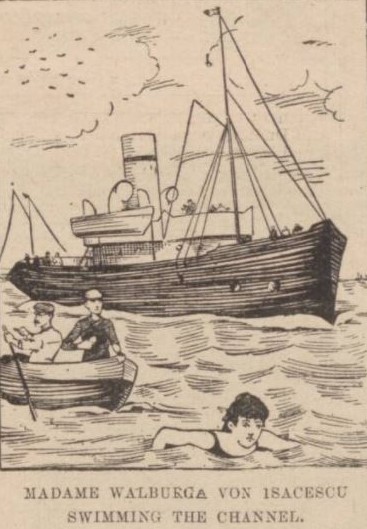
Penny Illustrated Paper
15 September 1900, page 6
She went to England again to make further attempts in subsequent years, but after exploring all the possibilities she returned home in 1901 without making any further attempt, and again in 1902 and 1903.
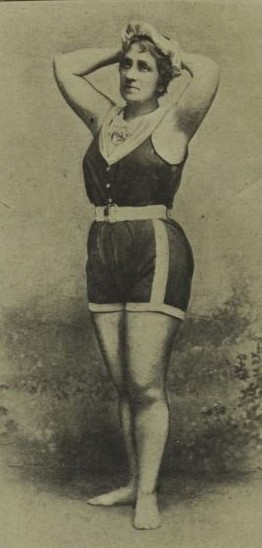
Baroness Isabella Walpurga von Isacescu circa 1900
She was convinced that she had to repeat Webb’s path from Dover to Calais and not vice-versa. In 1903, she was accompanied by two other Viennese aristocrats, Princesses Obolenski and Lubomicki, and was trained by the famous swimming expert, Marquis Bibbero.
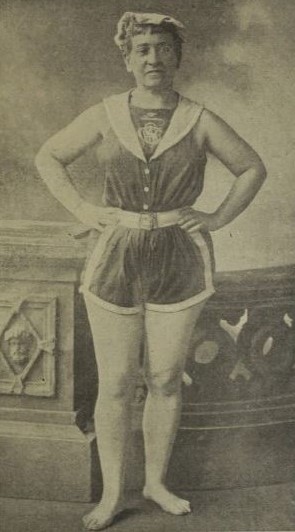
Baroness Isabella Walpurga von Isacescu circa 1902
Reports of her efforts went around the world. She proved to be a swimmer of great endurance and ability. It would have been a sporting event of great impact and might have stimulated the early inclusion of women’s swimming in the Olympic program and certainly would have increased the perception of women’s capabilities among the male dominated swimming fraternity. The Baroness was aware of this aspect, having declared
It is the age for women. We have conquered the prejudices, which so long kept us in the background, and we are resolved to show that in feats of endurance, as well as in brain efforts, we are equals of man[2]
She provided at her own expense the logistical support. Although belonging to the aristocratic class, the Baroness was not rich. In order to live she had to work, being the administrator of the north railway station of Vienna, a responsible position that she held until 1920. Commenting on her lack of sponsorship, private or a newspaper, she stated
Because I am a woman[3]
Who was Baroness Walpurga von Isacescu? She was a swimmer accustomed to long distance endurance swimming, preferably in the Danube, but without competitive ambitions. In 1899, she had participated in the Austrian long-distance championship, finishing in 5th place. In 1906, she participated in the Through Paris, ranking last and 17th among the amateurs.
She was born in Vienna very probably[4] in 1852, the daughter of an officer of the Vienna railway station, and at 16, she married Dimitri von Isacescu, a noble from Bucharest, going to live in the capital of greater Romania. After twenty years, her husband died and Walpurga returned to Vienna assuming the post that her father had occupied. During her stay in Romania, she had become a skilled equestrian. Back in Vienna, she devoted herself to cycling, but soon was bored and switched to swimming, joining the women’s section of Erste Wiener Amateur Schwimmclub (EWASC)[5].
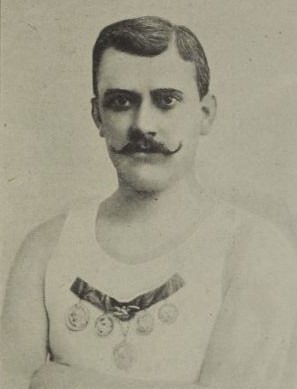
Anderle Alois
Photograph by Anton Schisal of Vienna
Water soon became her second element and she like to engage in long swimming tours. On 23 July 1899, together with Alois Anderle[6], she swam in the Danube from Bratislava to Vienna, for 61 kilometres in almost 7 hours. On 29 July 1900, still in the Danube, followed by a canoe paddled by the oarsman Eugen Pobisch and holding a bag with food, she travelled 77 kilometres from Stein to Vienna, taking just over 8 hours. With this background in distance swimming in open water, in 1900 she attempted the English Channel, which the Viennese newspapers followed closely, the reporters noting that the skills of the Baroness were far superior to those of several men. On 2 and 9 December, with 53 years old Ludwig Finke von Westerwell, they crossed, against the tide, the Danube in 9 minutes, despite the 5 degree temperature of the water. In early August 1901, with a view to announcing another possible Channel attempt, she swam in the Thames from Tower Bridge to Temple Pier, ultimately expressing a negative judgment on an even more polluted river than the Seine, where she had swum in 1899[7].
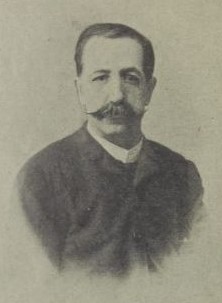
Finke von Westerwell
On 8 September 1902, the Baroness swam from Melk to Vienna in 12 hours and 21 minutes. After failing to cross the Channel, the Baroness continued in successive years her ong distance swims in the Danube, while following closely the attempt on the Channel by the famous Australian champion Annette Kellermann in 1905. In 1906, the paths of the two swimmers crossed. On 3 June, the Baroness swam 37 kilometres in the Danube between Tulln and the military swimming school in Vienna. Kellermann issued a challenge to the Baroness, but because of her allegiance to amateur code she did not accept. However, rather than swimming head to head, on 11 June she swam in parallel to her, diving off some minutes after the Australian and arriving about 25 minutes after her[8]. Unlike Kellermann, the Baroness did not ask for any escort boats, since, she said, she knew the route well[9]. Hearing of the details of this event, the famous William Henry, secretary of the Royal Life Saving Society, in an interview identified the Baroness as a professional, although the Baroness refuted this interpretation [10].
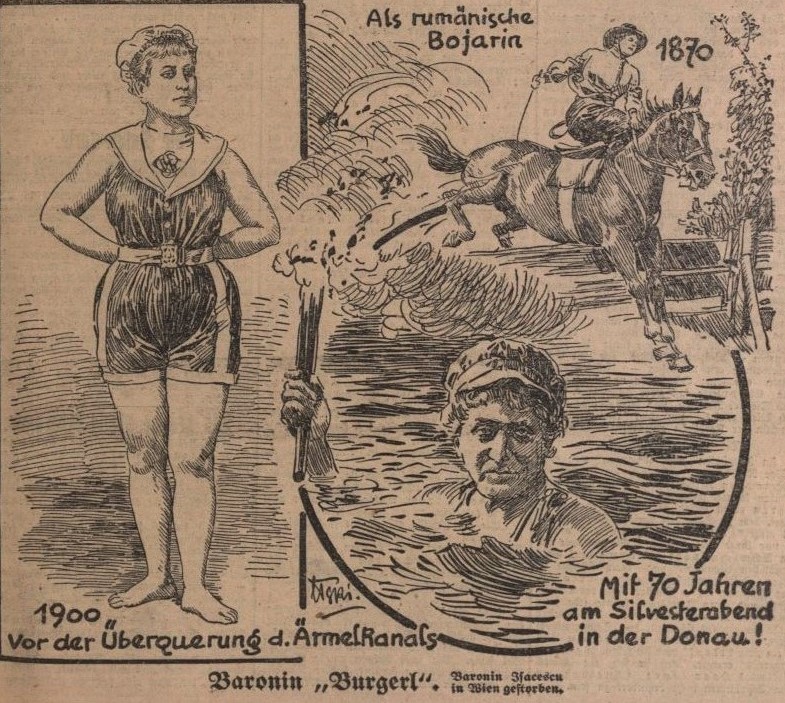
Illustrierte Kronen Zeitung
21 May 1925, page 1
In the last years of her life, swimming remained the favourite pastime. The press remembered often her magnificent failure. Her love for swimming was very strong and the 71-year-old baroness appeared at a water promenade on Saint Sylvester entertainment holding a torch. Unfortunately, the baroness to become ill and she had to give up swimming until the end of her life on 5 May 1925. She was very popular; she lived in the centre of Vienna at Volkswehrplatz 20. The young people and the inhabitants of the 2nd district called her Baronin burgerl (Our Baroness citizen) for her kind and affable manner[11].
Article © of Gherardo Bonini
References
[1] Sporting Life, 6 September 1900, p. 4; London Daily News, 7 September 1900, p. 7 that used first the term magnificent failure; Sport und Salon, 13 September 1900, p. 17; Cornubian and Redruth Times, 14 September 1900, p. 7
[2] Northants Evening Post, 9 August 1902, p. 2
[3] Nottingham Evening News, 8 August 1901, p. 6
[4] Most of information regarding her life, Illustrierte Kronen Zeitung, 21 May 1925, pp. 1-2 that stated 73 years old, but not specifiying whether born in 1851 or in 1852. Other sources indicated birth date 1865 or 1870.
[5] Illustrierte Kronen Zeitung, 21 May 1925, p. 2
[6] He represented Austria in Paris Olympics of 1900
[7] Indian Daily News, 5 September 1901, p. 3
[8] Neues Wiener Tagblatt, 13 June 1906, p. 8 wrote the times differed for 12 minutes, while Allgemeine Sport Zeitung, 17 June 1906, p. 748, for 24 minutes.
[9] Allgemeine Sport Zeitung, 17 June 1906, p. 748
[10] Sporting Life, 13 August 1906, p. 2
[11] Illustrierte Kronen Zeitung, 21 May 1925, p. 2

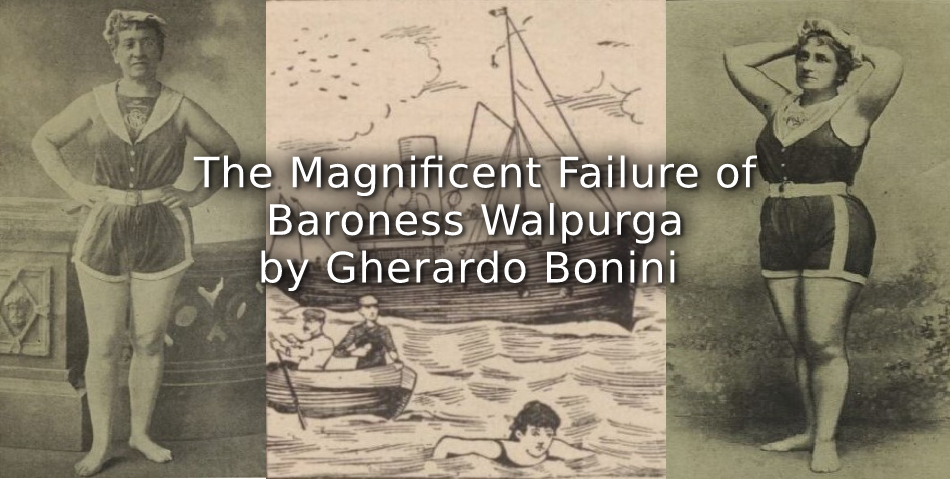
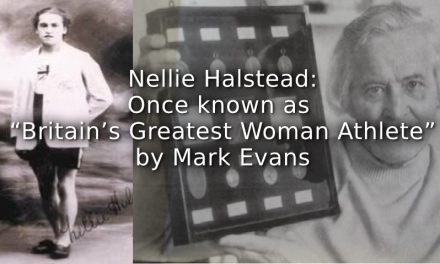

![“And then we were Boycotted”<br>New Discoveries about the Birth of Women’s Football in Italy [1933] <br> Part 12](https://www.playingpasts.co.uk/wp-content/uploads/2025/03/Marco-Part-12-440x264.jpg)

Very interesting article about a remarkable woman.
What I do not understand is the interpretation/translation ‘Our Baroness citizen’ for ‘Baronin Burgerl’. Burgerl or Burgi is a common Austrian abbreviation/nickname for ‘Walpurga’, so this refers to her first name.
Dear Anneliese,
Vielen Dank wirklich ! Sincerely, I did not know the information you have provided. No one told me it.
Again, many thanks for your help. I will add your note on my files.
Freundlich, Gherardo